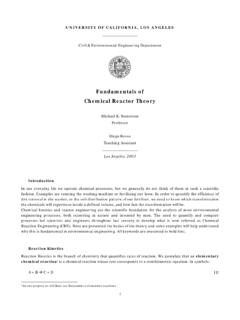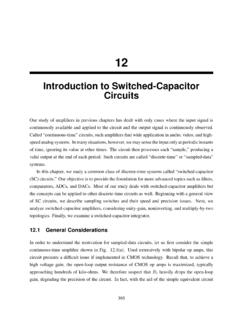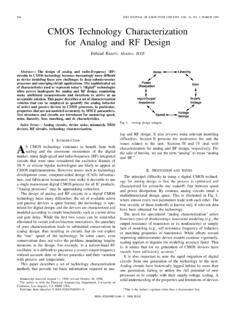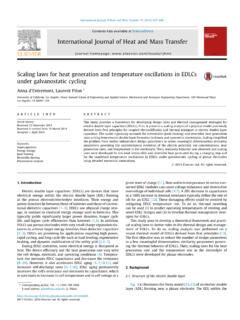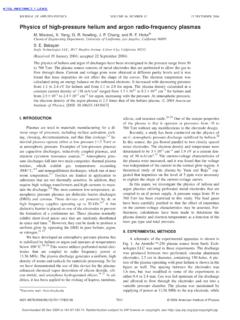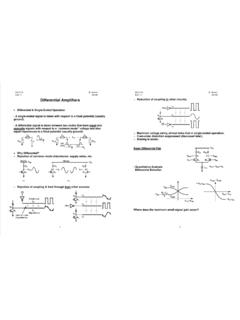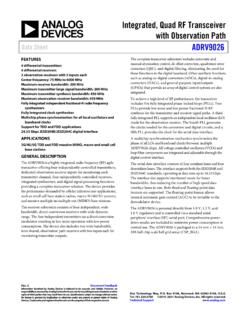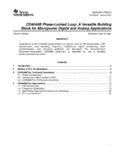Transcription of The Biquadratic Filter - University of California, Los Angeles
1 A CirCuit for All SeASonSBehzad Razavi IEEE SOLID-STATE CIRCUITS MAGAZINE spring 2018 11 TThe Biquadratic Filter , also known as the biquad, dates back to the 1960s [1] [3] but still serves as an essential building block in analog Filter design. In this article, we study this circuit s properties and design General BiquadThe biquad is a second-order Filter whose transfer function is given, in the general case, by ().Hsasbscasbsc22221211=++++ (1)Here, the numerator coefficients can be chosen to yield a low-pass, band-pass, or high-pass response.
2 For ex-ample, ab011== leads to a low-pass Filter (LPF), the focus of our study here. To realize higher-order filters, biquad sections can be Need for Complex PolesWe typically begin the design of filters by deciding on the order and shape of their frequency response. For example, Wi-Fi receivers commonly employ a fifth-order LPF to suppress unwanted channels. However, for a given order, the roll-off from the passband to the stopband can be made sharper if some peaking or ripple is is in this spirit that we turn to transfer functions having complex poles. We explain the thought process behind this point by means of an ex-ample. Consider a low-pass biquad characterized by the following two (equivalent) transfer functions: ()HssQsnnn222~~~=++ (2).
3 Ss2nnn222g~~~=++ (3)Here, n~ denotes the natural fre-quency, Q the quality factor (also called the pole Q), and g the damping factor. The first form is common in fil-ter design and the second in control theory ( , in phase- locked loops ). Noting that /( ),Q12g= we will use the two forms intuitively observe that, if ,Q"3 the two poles approach jn!~ and the system becomes unstable. Thus, the value of Q determines how much the poles depart from the real axis and how much peaking ()Hsj~= has. The two poles can be expressed as ,QjQ2141,pnn122!~~~=-- (4)taking on a complex value if .Q12> But complex poles do not necessar-ily imply peaking. Writing (),HjQnnn222224~~~~~~=-+^chm (5)we find that the denominator falls to a minimum at /Q112n2~~=-a^h if /.
4 Q222 In such a case, ()Hj~ exhibits a peak equal to Q /Q1142-^h (Figure 1). It is help ful to remember that for ,Q1= the peak-ing is about dB, and it occurs at ..071an~~=With these preliminary develop-ments, we can now evaluate the stopband attenuation of H at a given frequency for the case of real or complex poles. As an example, we seek the rejection at a frequency The Biquadratic FilterDigital Object Identifier of publication: 22 June 2018 2211 111 H( ) Q4Q2Q <22Q > a = n 2Q2 Figure 1: Peaking in biquad frequency spring 2018 IEEE SOLID-STATE CIRCUITS MAGAZINE equal to twice the 3-dB bandwidth of the Filter . This choice represents a scenario of interest in radio-fre-quency (RF) receivers where the adja-cent channel must be suppressed.
5 The 3-dB bandwidth is given ~~=-+-+-cm=G (6)If ,Q12= the two poles are real and equal (as in an open-loop cas-cade of two first-order RC sections), .,064dBn3~~=- and the attenuation provided by H in (5) at 2dB3~- is On the other hand, if ,Q1= .127dBn3~~=- and the attenua-tion at 2dB3~- reaches That is, by allowing dB of peaking at the edge of the passband, we improve the rejection at 2dB3~- by (./.). 379 0 of Complex PolesIt can be shown that a passive net-work consisting of only resistors and capacitors does not provide complex poles [4]. We must therefore seek active implementations that exploit feedback to create such us begin with the negative-feedback system shown in Figure 2, where two lossless integrators ap-pear in the loop.
6 Note that Y is ne-gated as it enters the input summer. This negation can be removed if one integrator inverts and the other does not. We have for this system (),XYsskkkk21212=+ (7)obtaining imaginary poles if .kk0122 To stabilize the system, we must add a term proportional to s in the denominator. This can be accomplished by a number of tech-niques, for example, 1) we can add a zero to the open-loop transfer func-tion, as practiced in type II phase- locked loops , or 2) we can make one of the integrators lossy, , we can change /ks1 to /().ksa1+ The latter is realized if a fraction of the integrator s output is returned to its input without phase shift.
7 Illustrated in Figure 3(a), such an arrangement yields ().ABsskk11a=+ (8)The circuit implementation is straight-forward [Figure 3(b)] and gives ()().VVsRRCsR1inout1212=+- (9)We can now incorporate the lossy integrator of Figure 3(a) in the archi-tecture of Figure 2 [Figure 4(a)]. In XY+ k1sk2sFigure 2: A Filter using two lossless inte-grators in a loop. AB+ k1sR2C1R1 VinVout+ (a)(b)Figure 3: (a) A lossy integrator and (b) its circuit + + + C1C2 RFRFVX+++ ++ XY+ k1sk2s(a)(c)(b)Figure 4: (a) the use of a lossy integrator in a biquad loop, (b) the tow thomas biquad, and (c) its differential version. IEEE SOLID-STATE CIRCUITS MAGAZINE spring 2018 13early Filter designs, off-the-shelf op-amps provided only a single-ended output, making it difficult to imple-ment noninverting integrators.
8 Thus, an inverting amplifier was inserted in the loop, leading to the circuit shown in Figure 4(b). Called the Tow Thomas biquad after Tow [2], [3] and Thomas [5], this topology requires only two op-amps if implemented in fully-differential form [Figure 4(c)].The biquad depicted in Figure 4(c) provides the following transfer function:()/,VVsRRRCCsRRCsRRRR inoutFFF2312232221=++ (10)yielding RRCC1nF312~= (11) .QRRRCCF2321= (12)Interestingly, n~ is independent of R2 whereas ,QR2? , the pole Q can be adjusted without changing .n~ More-over, both n~ and Q are independent of ,R1 which sets the passband gain according to //.
9 VVRR outinF1= These attributes facilitate tuning of the fil-ter (discussed below). Also, since the first integrator s output in Figure 4(c), ,VX is equal to ,VRCsout32- we write /(/)VVVVRC soutinX32in=- and con-clude that the circuit can act as a band-pass Filter as arrive at another biquad imple-mentation, let us first note that the in-verting amplifier in Figure 4(b) can be moved to the input [Figure 5(a)] without changing the transfer function. Next, we observe that the loss-inducing path in Figure 3(a) and realized by R2 in Fig-ure 3(b) need not return to the very in-put of the integrator; this path can even traverse additional stages placed before or after the integrator if such stages are free from phase shift [Figure 5(b)].
10 It is, therefore, possible to tie the left termi-nal of R2 to the input of the inverting amplifier, but we must ensure negative feedback. These thoughts lead to the Kerwin Huelsman Newcomb (KHN) bi-quad depicted in Figure 5(c).The KHN biquad s transfer func-tion is given by (),VVsasbsccinout22221=++ (13)where ()()cRRRRRR1412245=++ (14) aRRCC21312= (15) ()()bRRRRRCRR241213245=++ (16) .cRR245= (17 )It follows that RRRCCRn413125~= (18) ().QRRCCRRRRCRRRR1312541334512=++ (19)In this case, too, n~ is independent of ,R2 but Q is not. Thus, the pole Q can be adjusted without affecting.
